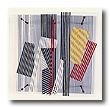The Blanton Museum of Art,
Feb 20, 2007 - Apr 22, 2007
Austin, USA
The Geometry of Hope
by María Amalia García
In this sense, the journey undergoes translation in terms of its presentation as a Museum piece: the lay-out of the rooms proposing an open and dynamic itinerary, as much as the use of great photographic displays of urban visions, enact the scenarios for these tours. The tour begins in Montevideo, focused on Joaquín Torres-García’s activity. From there we jump to the other margin of the Plata River shifting to Buenos Aires where a heterogeneous scenario of inquiries into abstraction is revealed: the debate here go from the semi-dada projects of the Madi group to the specifically concrete-art pursuits of Alfredo Hilto and Tomas Maldonado. Gyula Kosice’s Escultura móvil articulada (1948) is exhibited in The Geometry of Hope - a piece recently donated by Patricia Cisneros to MOMA- and also 14 variaciones sobre un mismo tema (1951-1952: 14 Variations on a Single Theme) by Tomás Maldonado, a key work in the regional development of concrete art.
Within this discussion, the next stop is Säo Paulo where other concrete art works are to be found. It is precisely more interesting to notice the similarities between Säo Paulo and Buenos Aires through the research carried out by the artists. Waldemar Cordeiro’s Idéia visível (1956) and Geraldo de Barros Função diagonal (1952) set out to objectify artistic discourse in the process of approaching the productive and perceptive specificity of visual arts. These artist’s research coincide with the inquiries by some Argentineans, such as Maldonado and Hilto, and with those of the Swiss artist Max Bill, who found committed fellow artists with whom to interact among Argentineans and Brazilians. The universality and objectivity of the artistic discourse and the concern with taking part in the objective, architectural, and urban environment, crystallized the concrete model. In this respect, the model advanced by The Geometry of Hope can be reformulated in terms of other narratives that include scenarios from Zurich, Milan or Valparaíso.
Following the given route, we go on to Rio de Janeiro where these inquiries take on a different trait. The "Metaesquemas" and "Relevos" by Hélio Oiticica, Planos em superfície modulada no 4 (1957) by Lygia Clark and the Livro da Criação (1959) by Lygia Pape reveal new and intense concerns. While these artists also worked by using modules and series, the "neo-concrete" conceptualization implied a profound breaking away from the model. "Falar ao [ç] Polho-corpo’" (3) incorporating the problem of subjective expression and the active participation of the viewer was the crux of the debate. In this respect, the ability to appreciate Lygia Pape’s o Livro da Criação, a little shown work and usually incompletely reproduced, is one of the exhibit’s highlights.
An exchange circuit emerges between Paris and Caracas. Alejandro Otero, Jesús Rafael Soto and Carlos Cruz-Diez’ activity in Paris at the end of the 40’s and the beginnings of the 50’s, and their participation in this scenario (primarily through the Denise René gallery), are keystones for understanding the presence and movement of the viewer as a new kind of datum in the plastic arts. Present at the exhibit are some of the main works of Venezuelan kineticism: Jesús Rafael Soto’s Desplazamiento de un elemento luminoso (1954) in which Soto forces the limit of the organizational capacity of the viewer’s visual system. Penetrable also is shown outside of the Museum, an installation that absorbs the viewer into a space brimming with color: a "topological movie" following Luis Pérez-Oramas’ observation in the catalogue. Besides his well known Tablón de Pampatar (1954), Alejandro Otero’s studies for architectural panels are shown here; these colorful octagonal compositions were put together with mosaics at the José Angel Lamas de Caracas amphitheater. An exceptional work by Carlos Cruz-Diez is shown: Physichromie 500 (1970), an opus of major proportions in red plexiglass that performs some sorcery as a result of the interaction between the relativity of color and our perceptual capacities.
|
![Ritmos cromáticos III [Chromatic Rhythms III] by Alfredo Hilto](images/ar_ hilto_02_md.jpg)
![Idéia visível [Visible Idea] by Waldemar Cordeiro](images/br_corde_01_md.jpg)
![Tablón de pampatar [Pampatar board] by Alejandro Otero](images/ve_otero_03_md.jpg)
![Pintura 9 [Painting 9] by Helio Oiticica](images/br_oitic_17_md.jpg)

![Função diagonal [Diagonal Function] by Geraldo de Barros](images/br_debar_01_md.jpg)
![Função diagonal [Diagonal Function] by Geraldo de Barros](images/ar_ hilto_02_im.jpg)


